
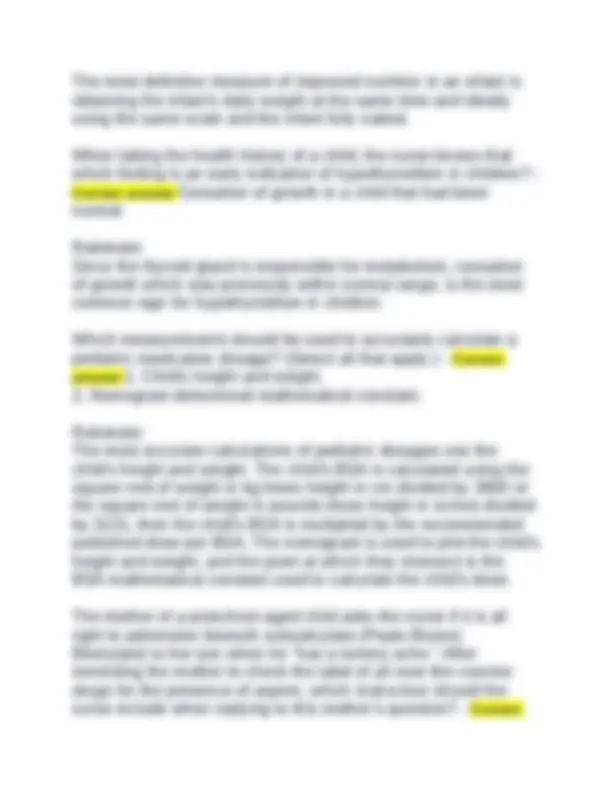
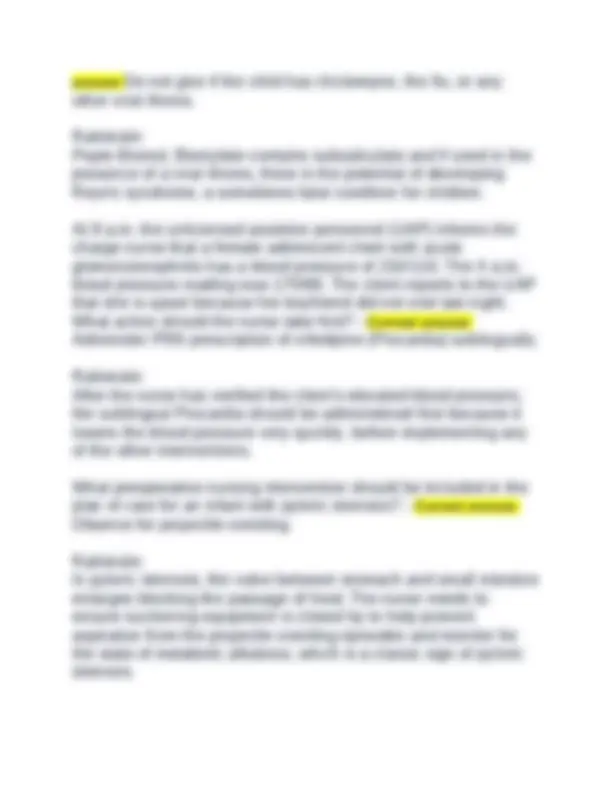
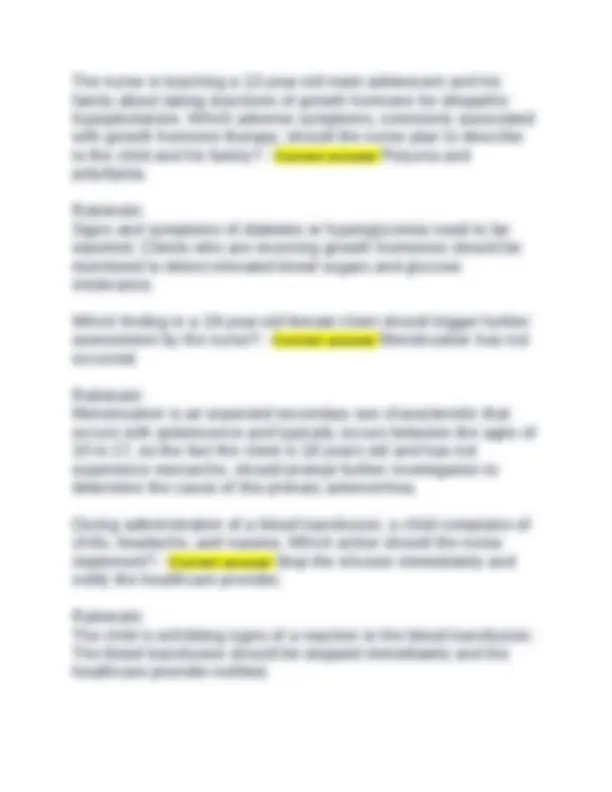
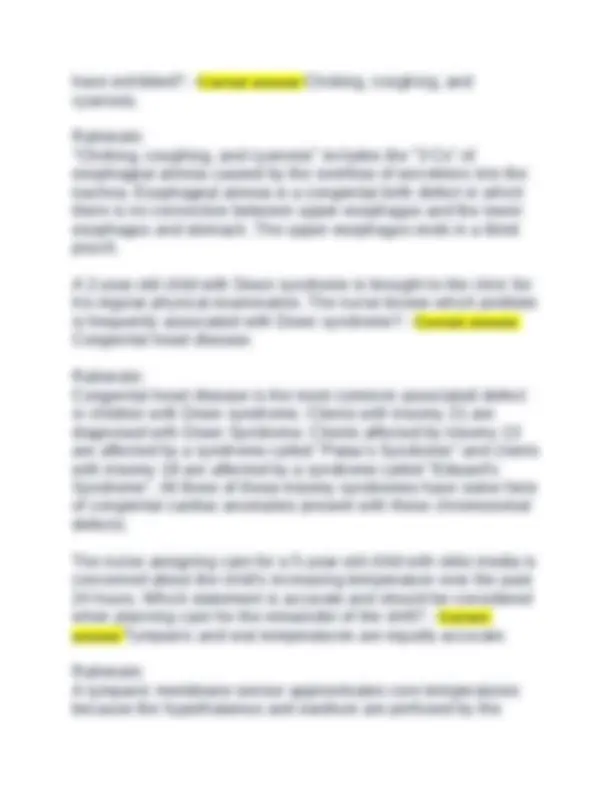

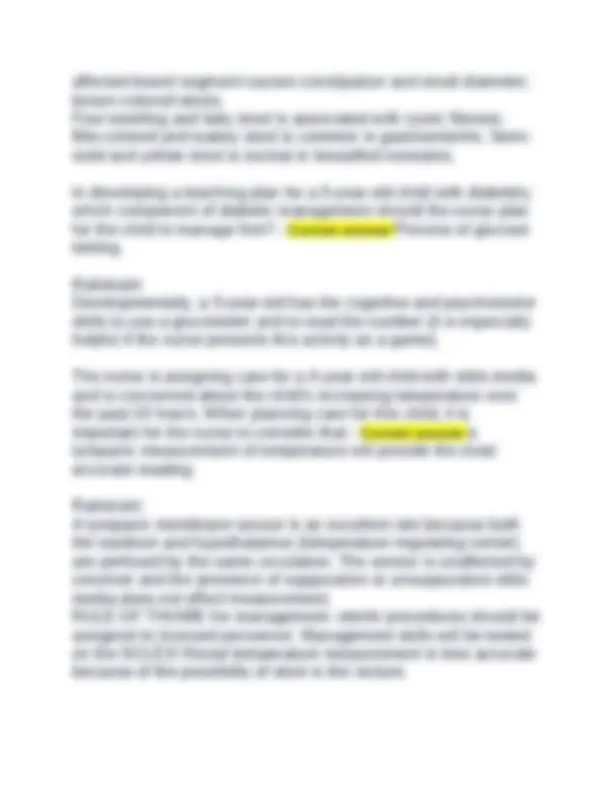
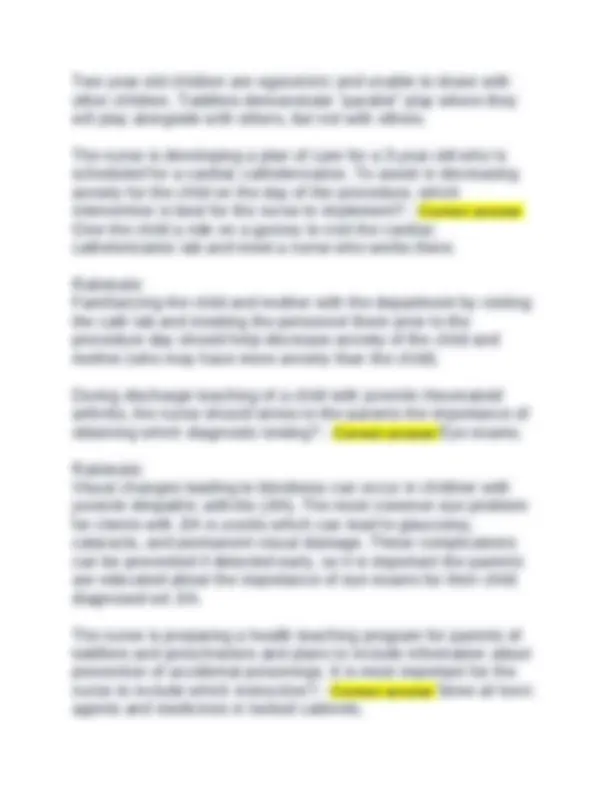
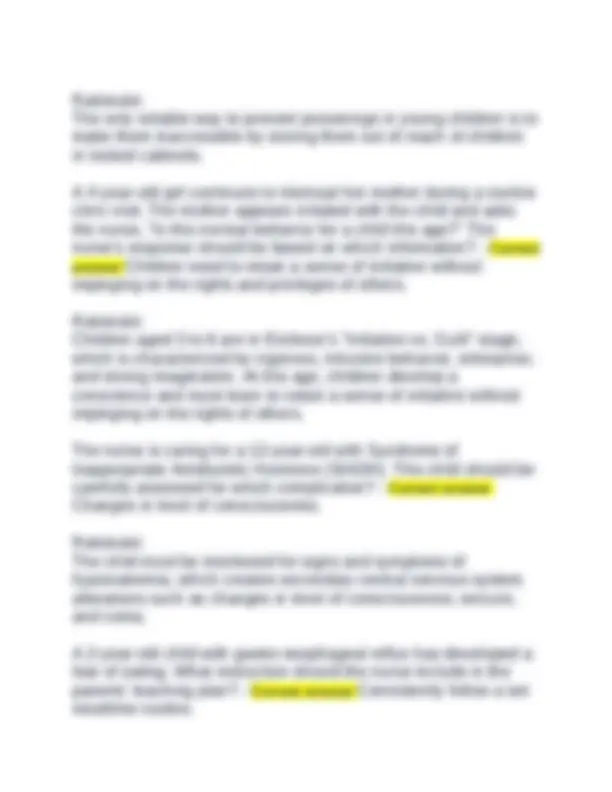
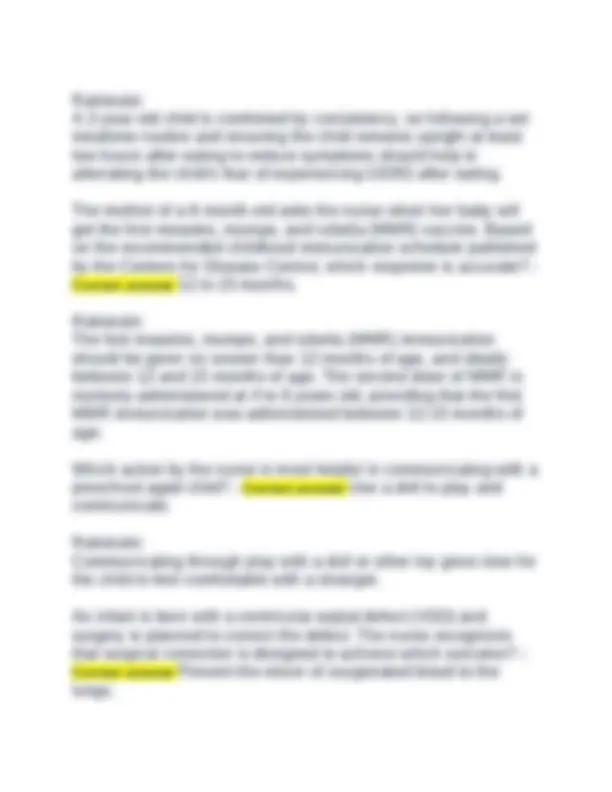
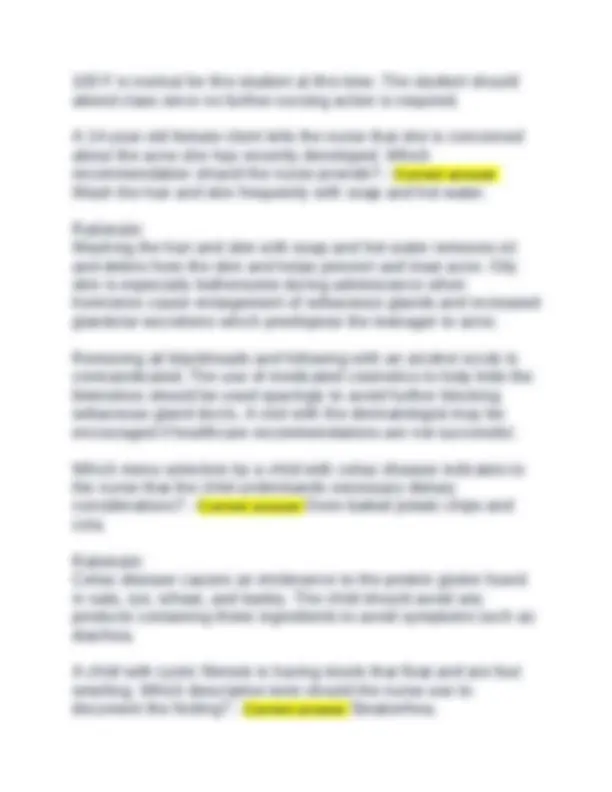
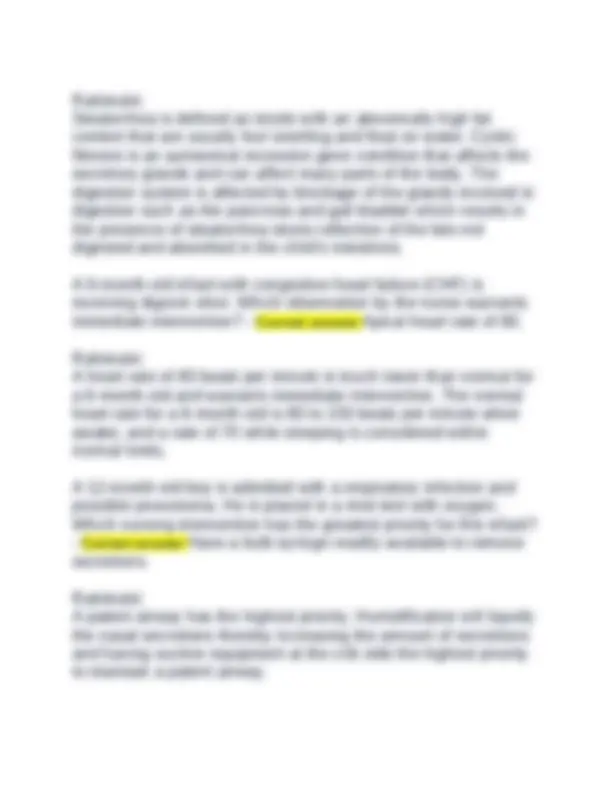
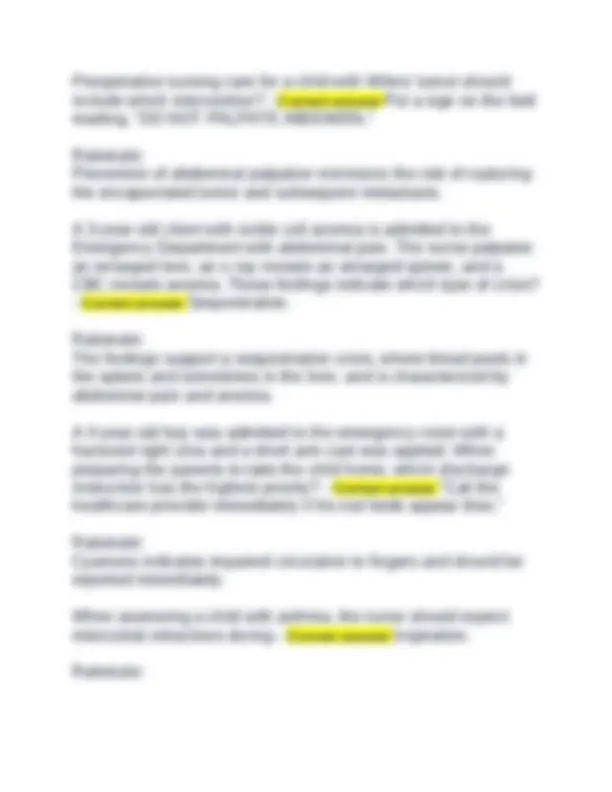
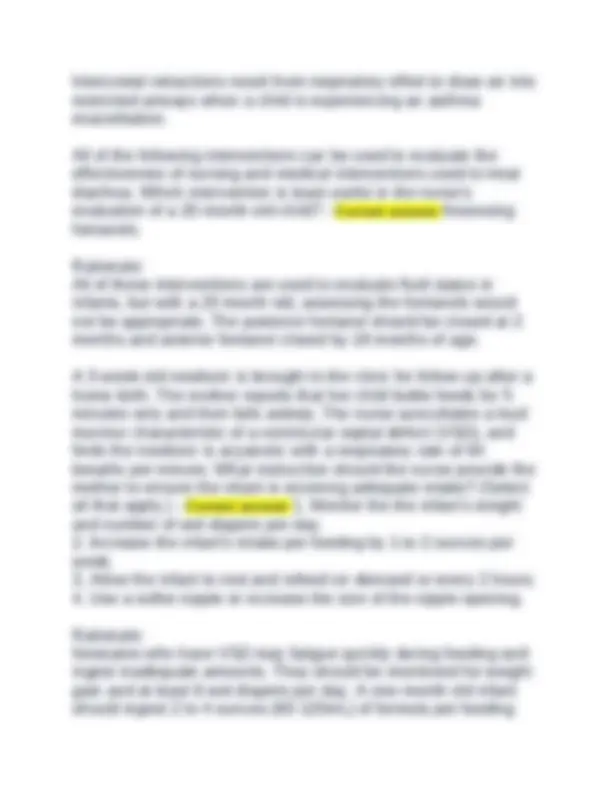
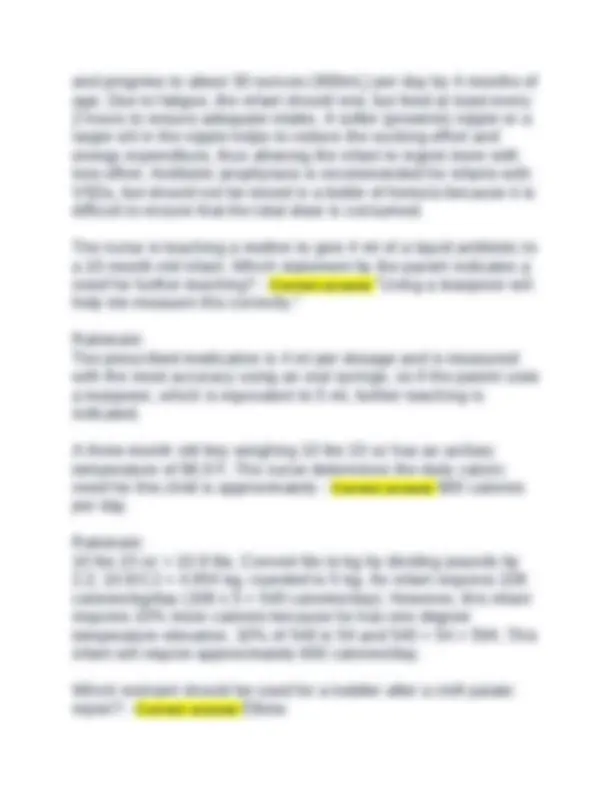
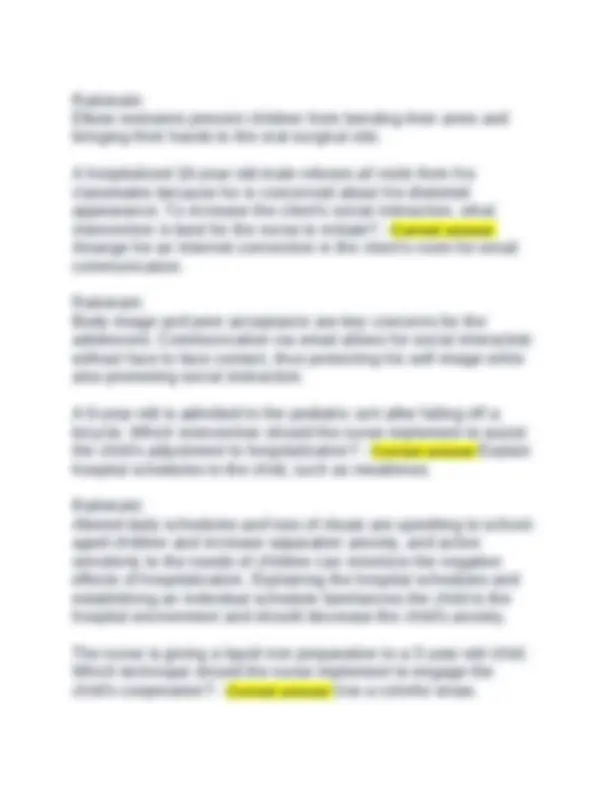
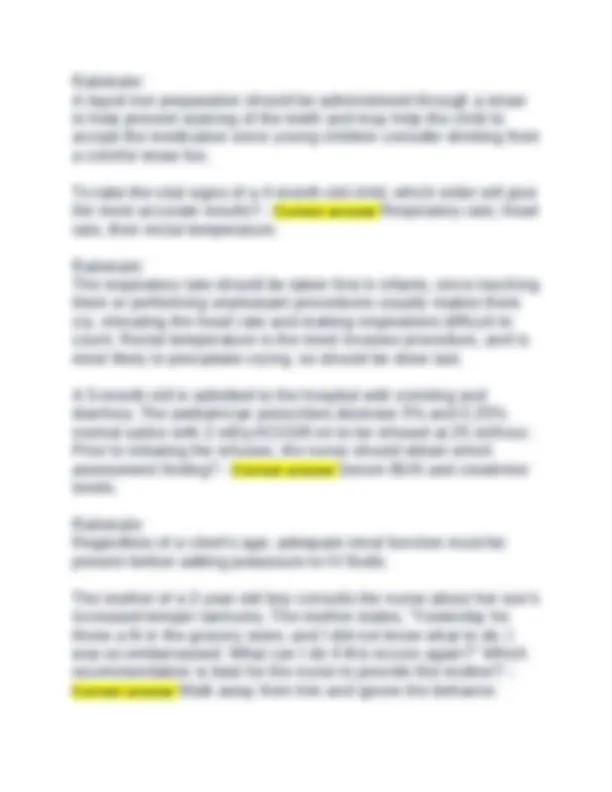
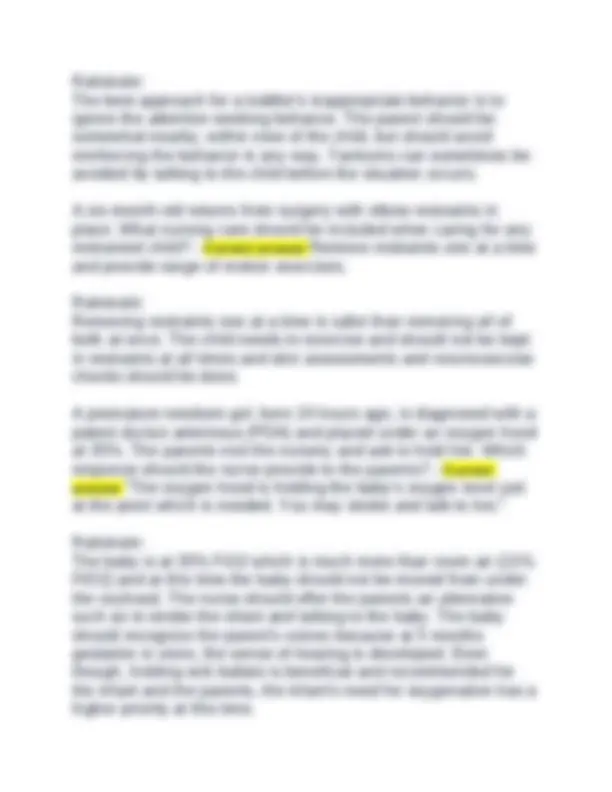
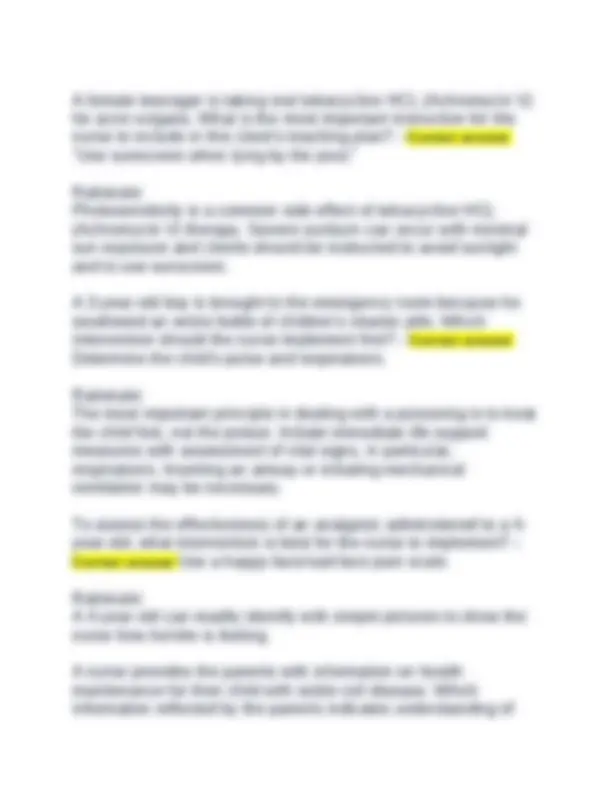
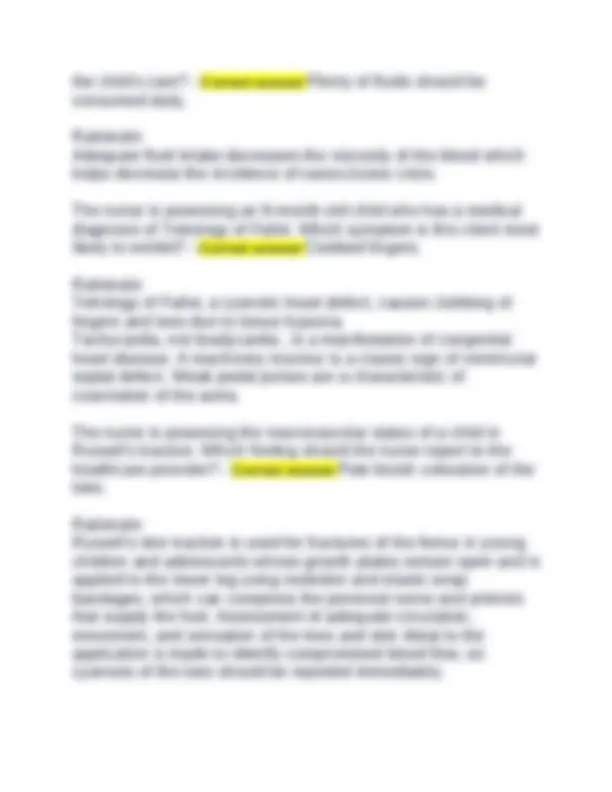
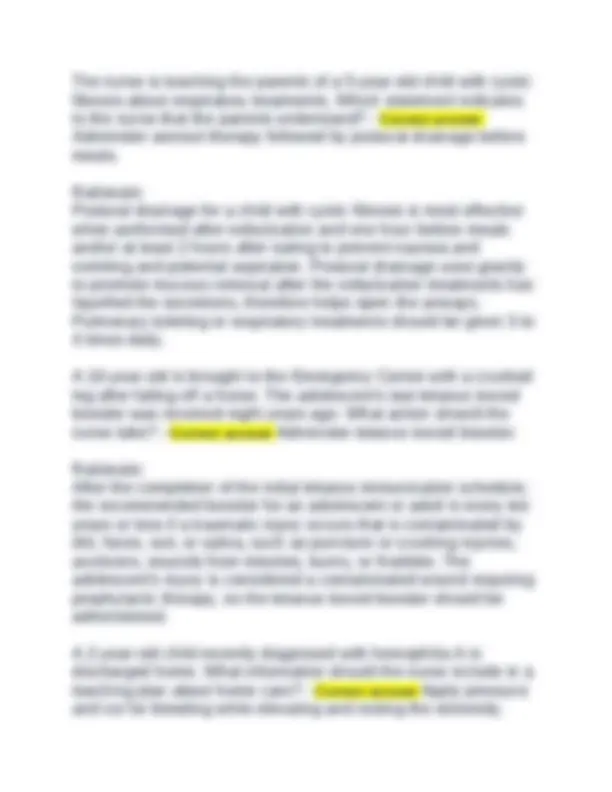
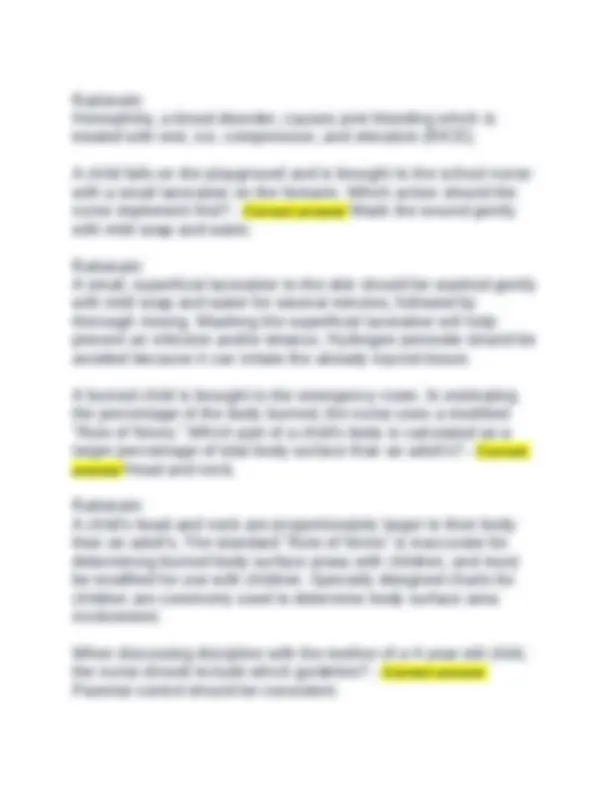
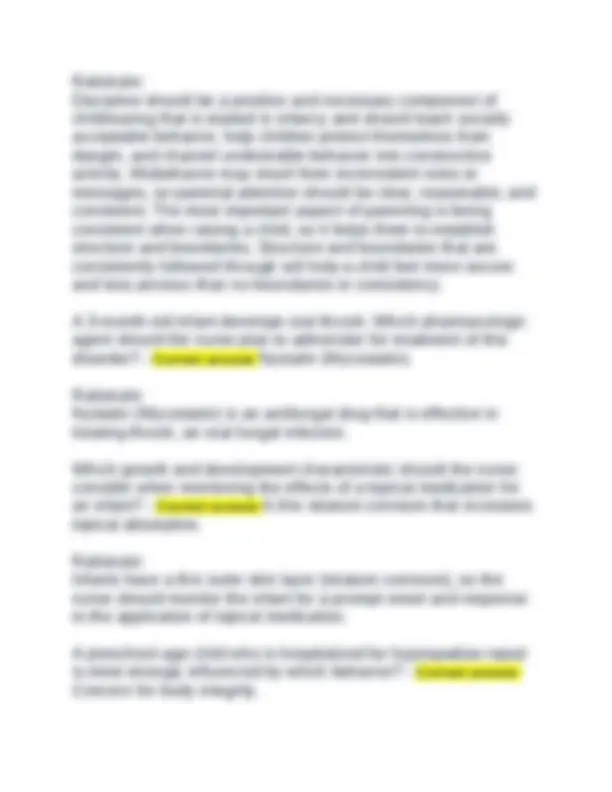
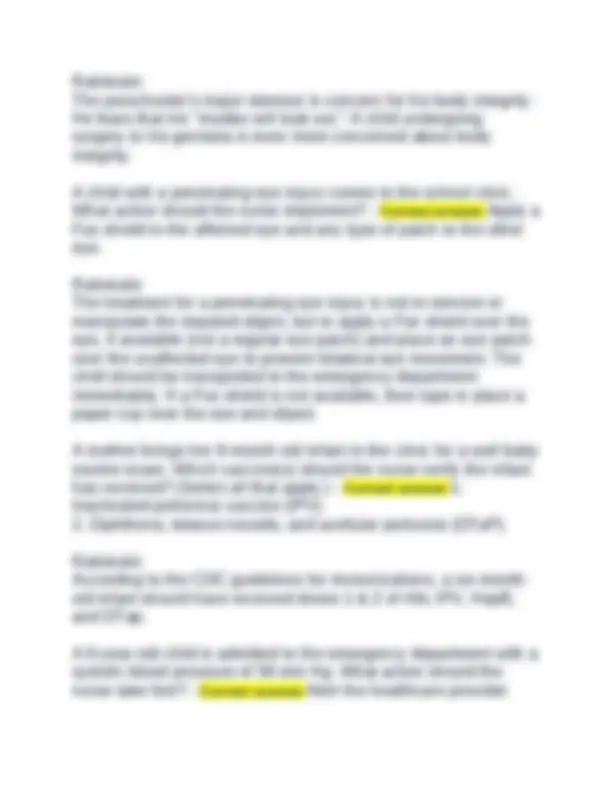
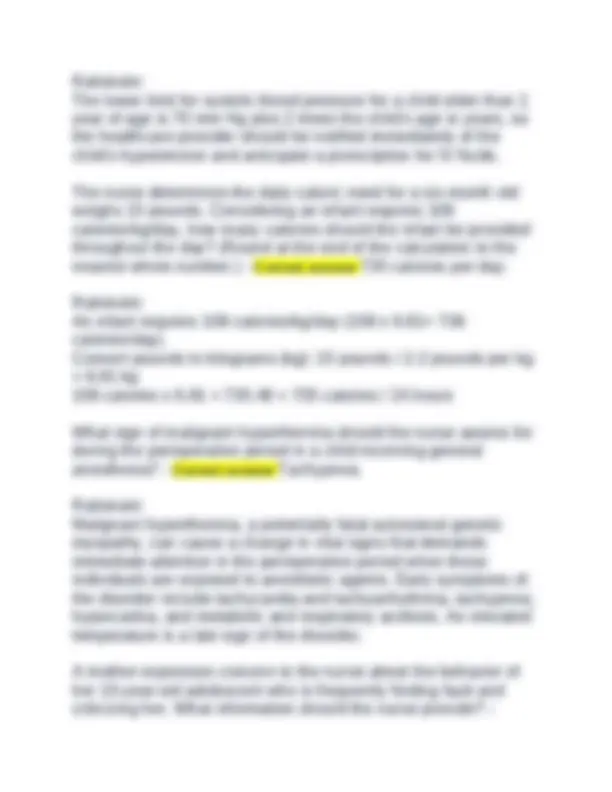
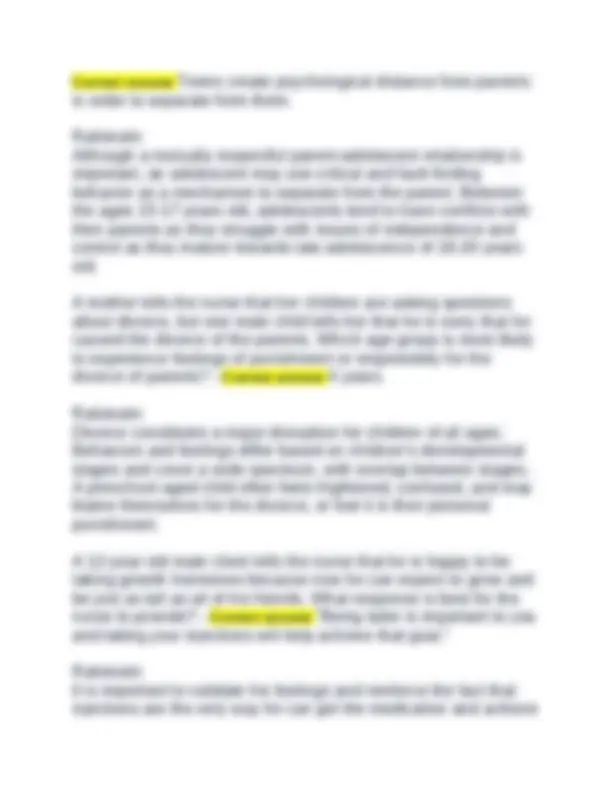
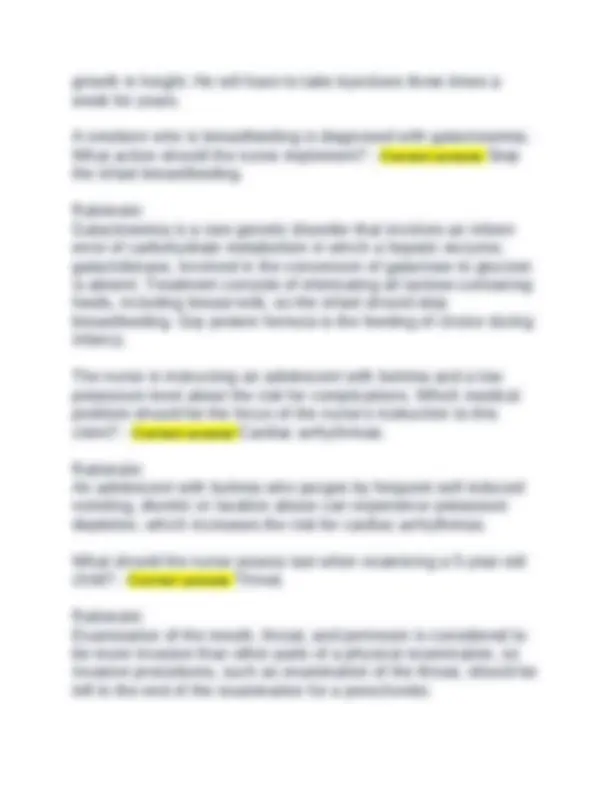
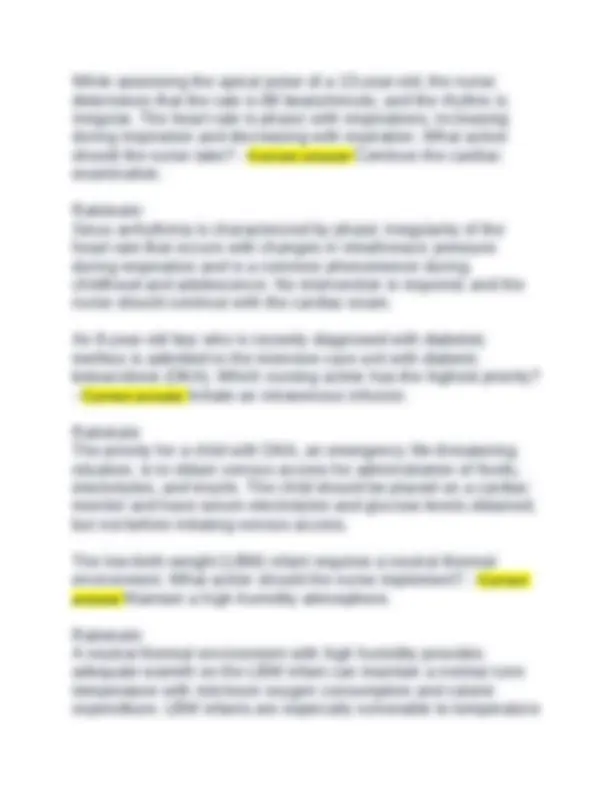
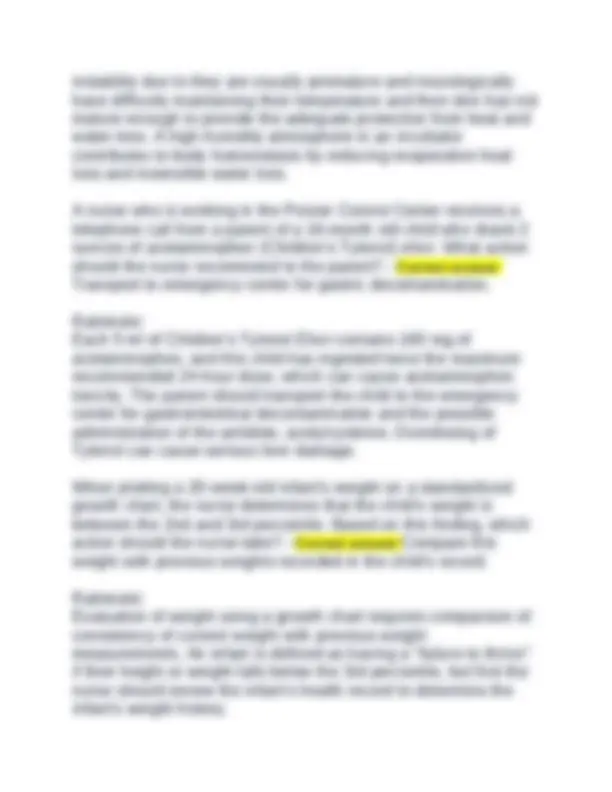
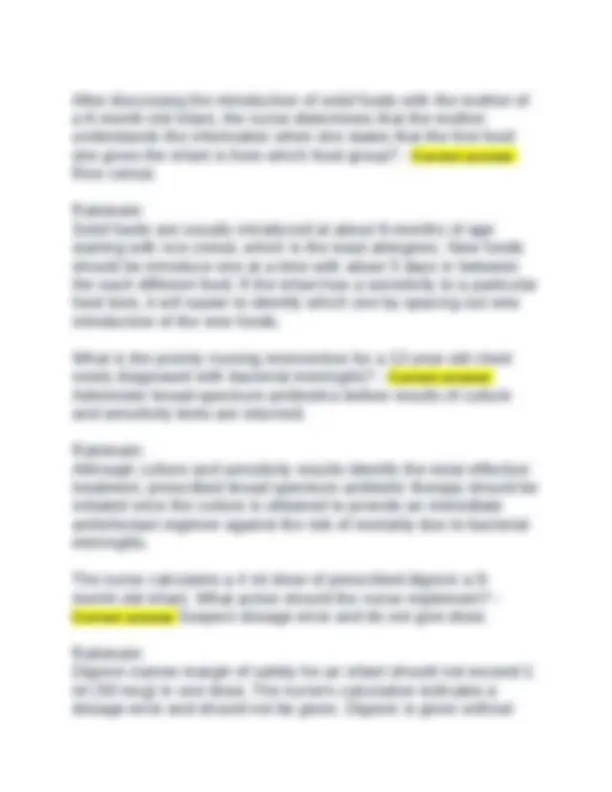
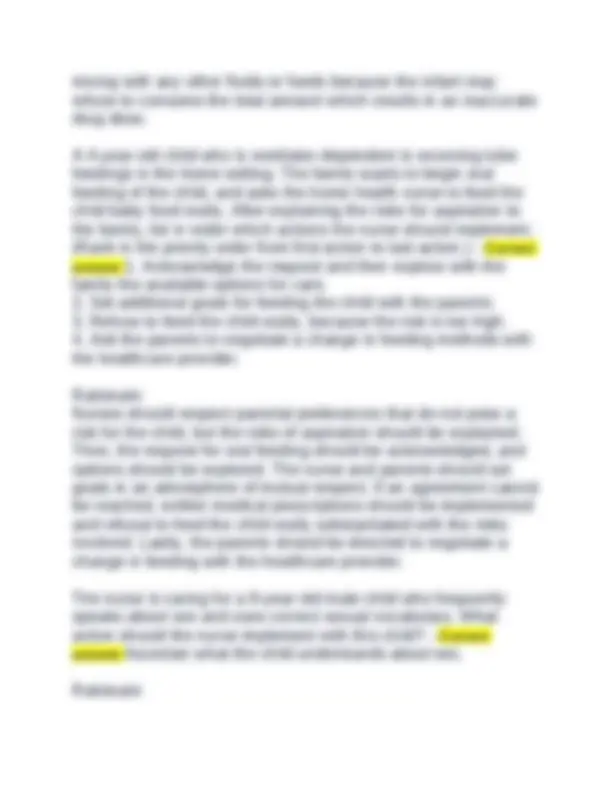
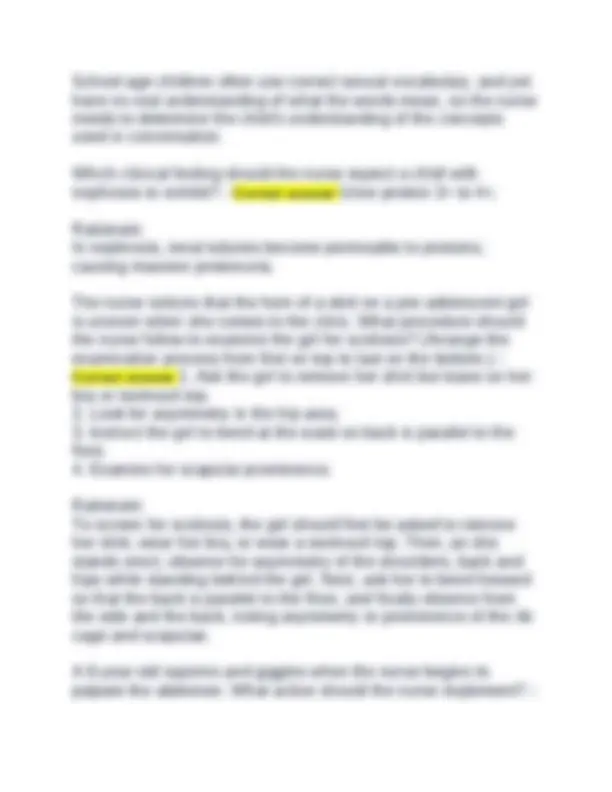
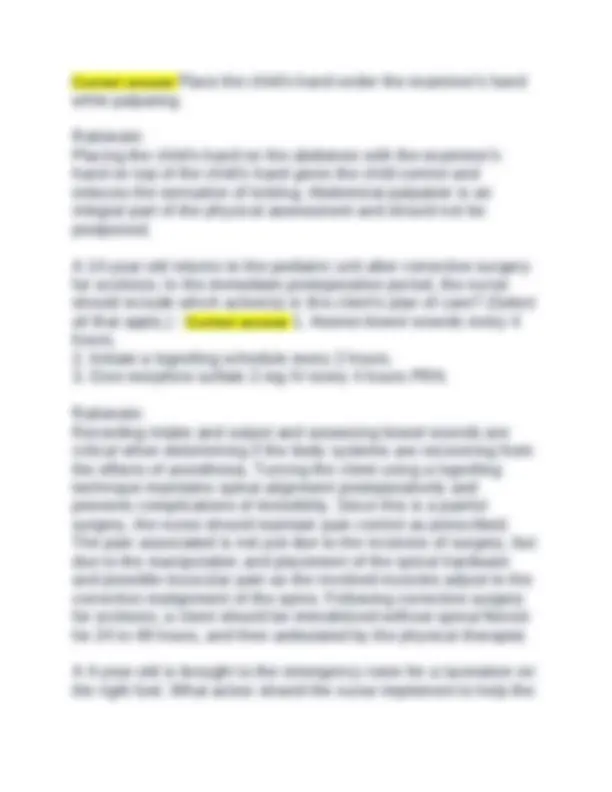
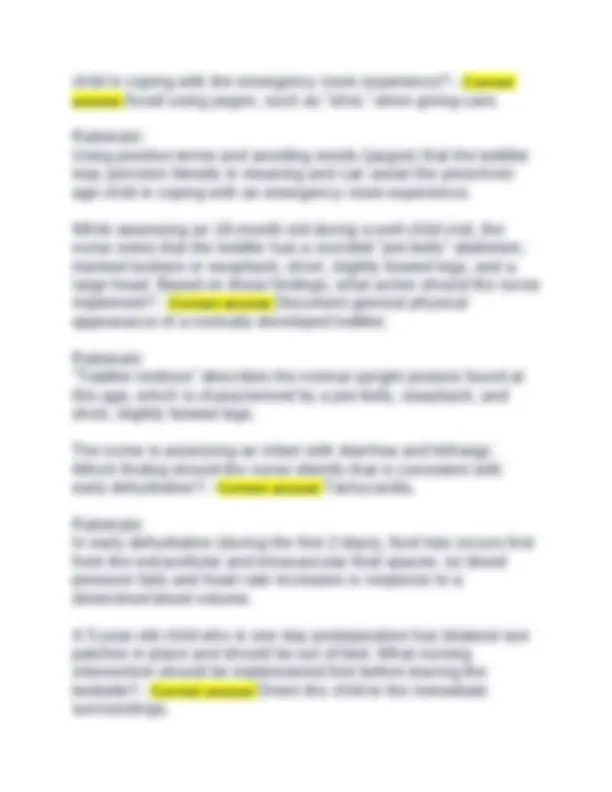
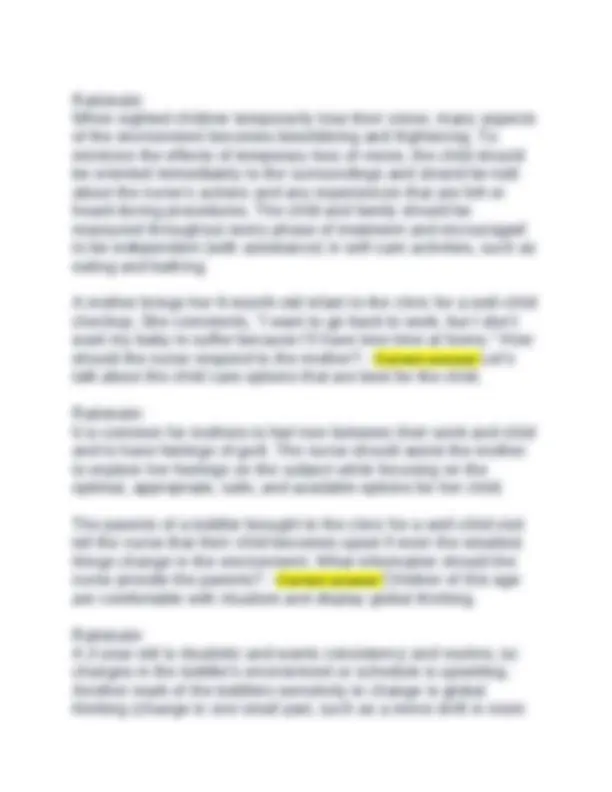
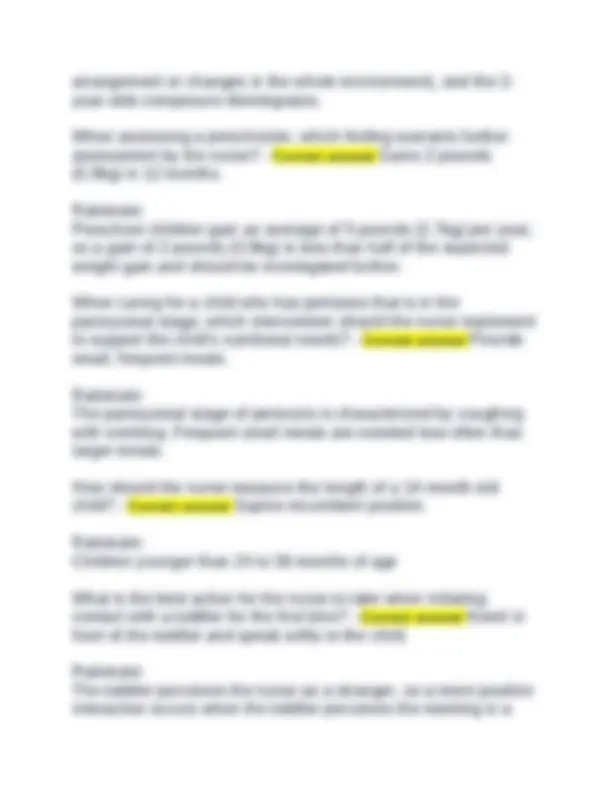
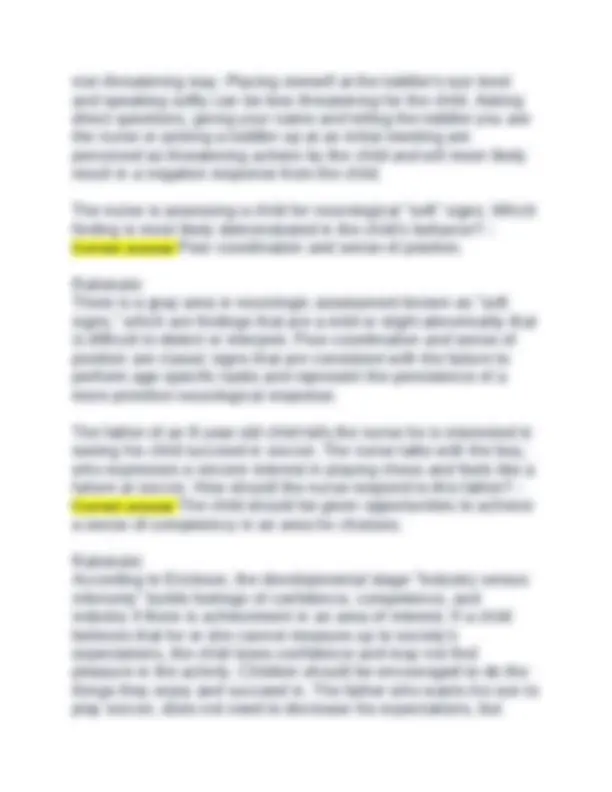
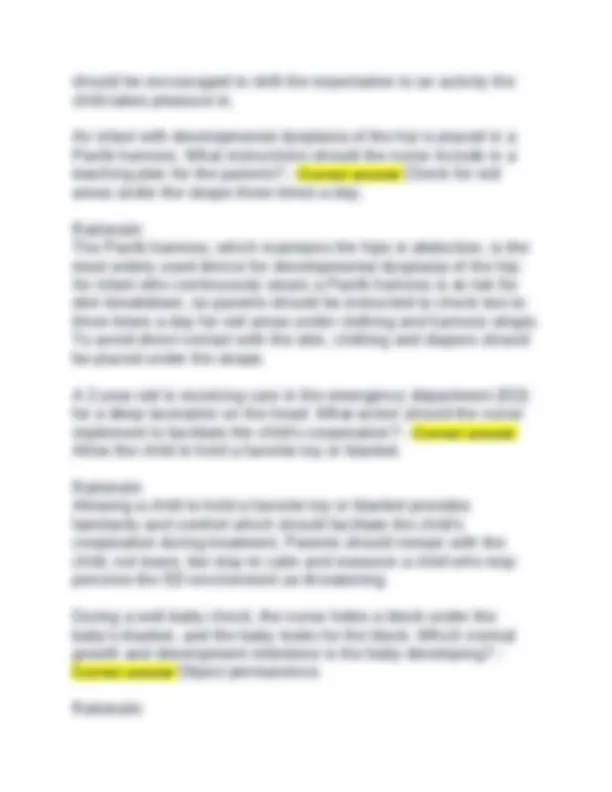
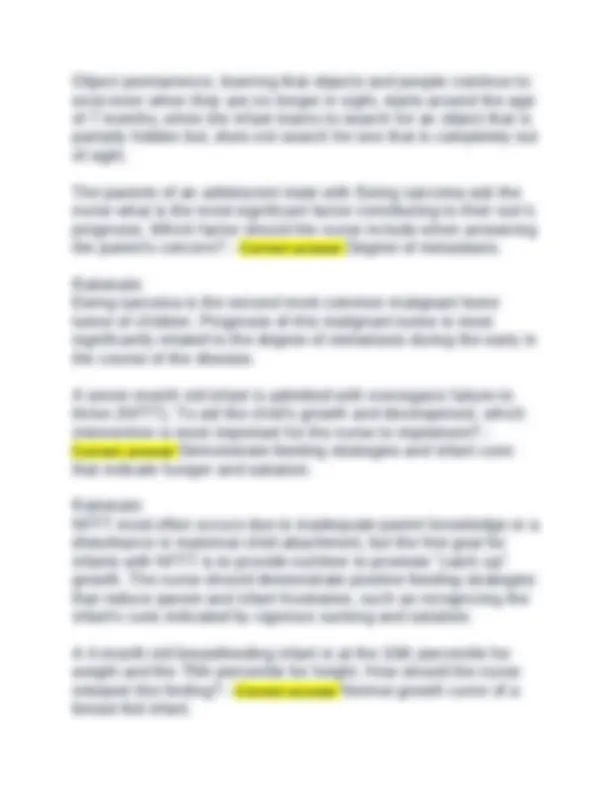
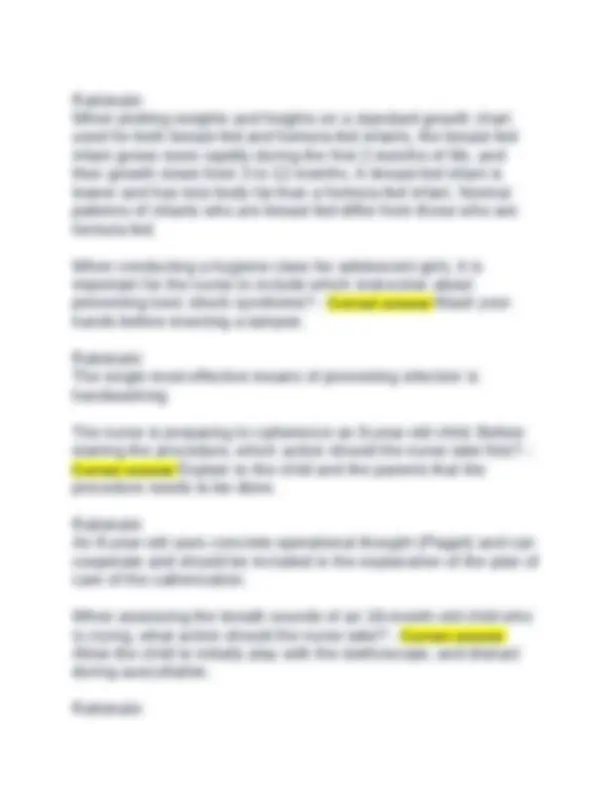
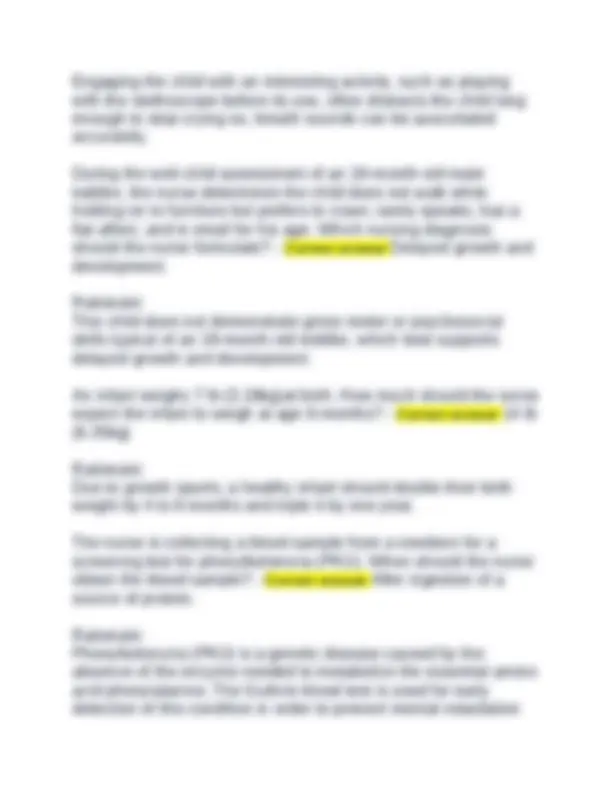
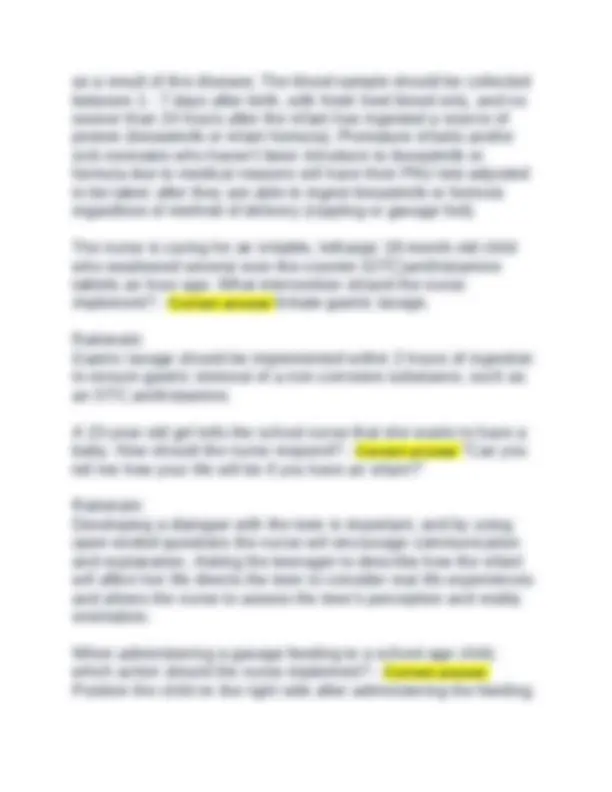
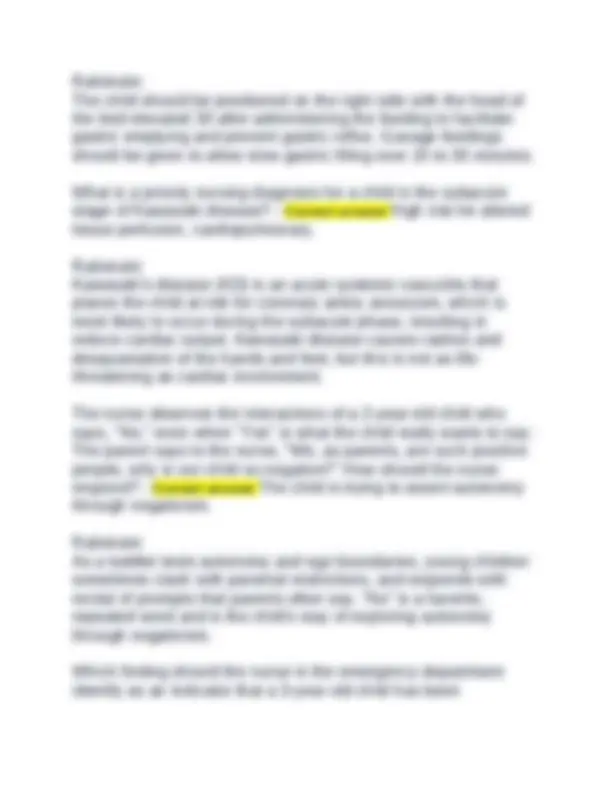
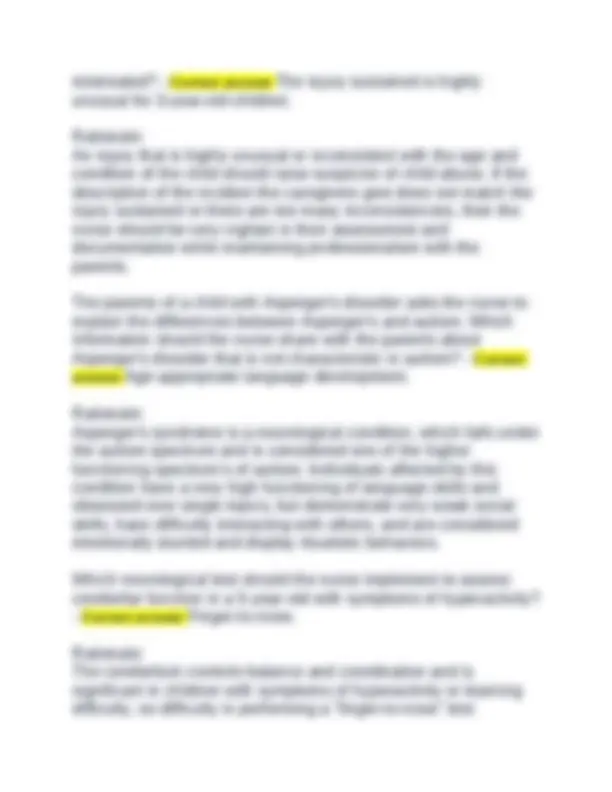
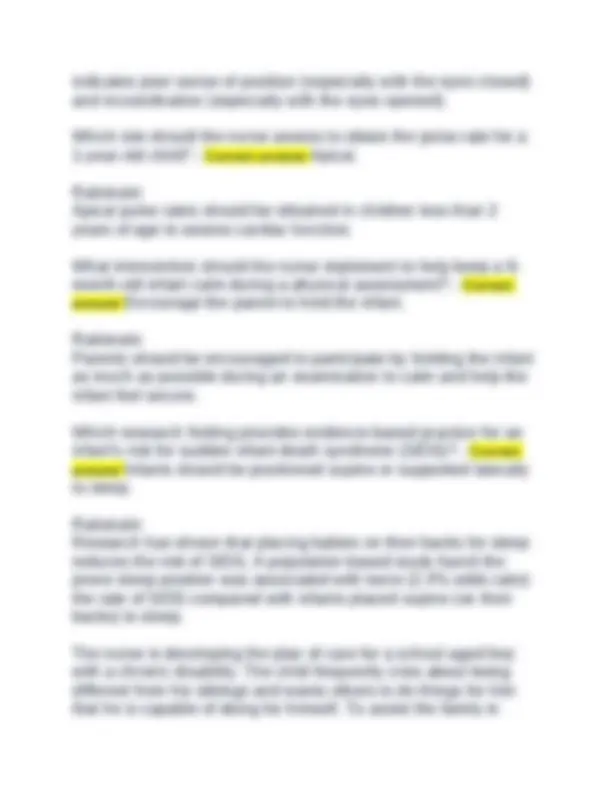
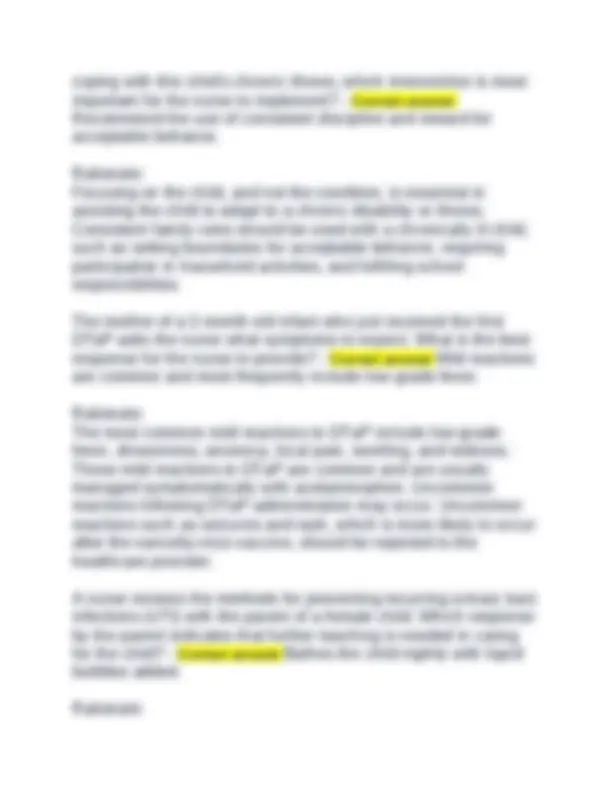
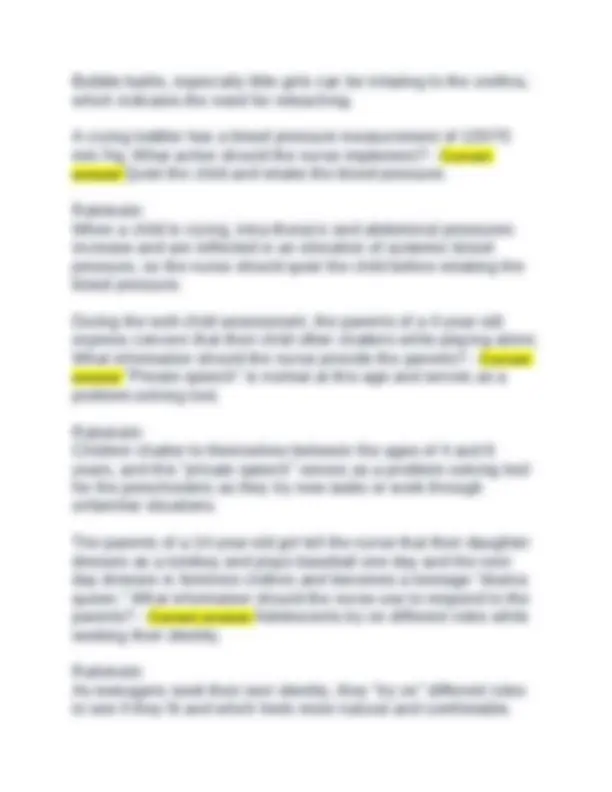
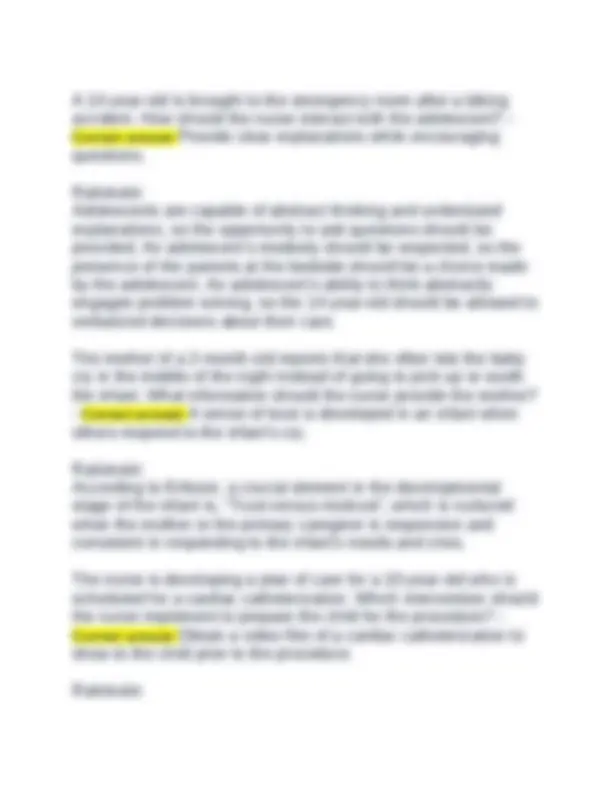
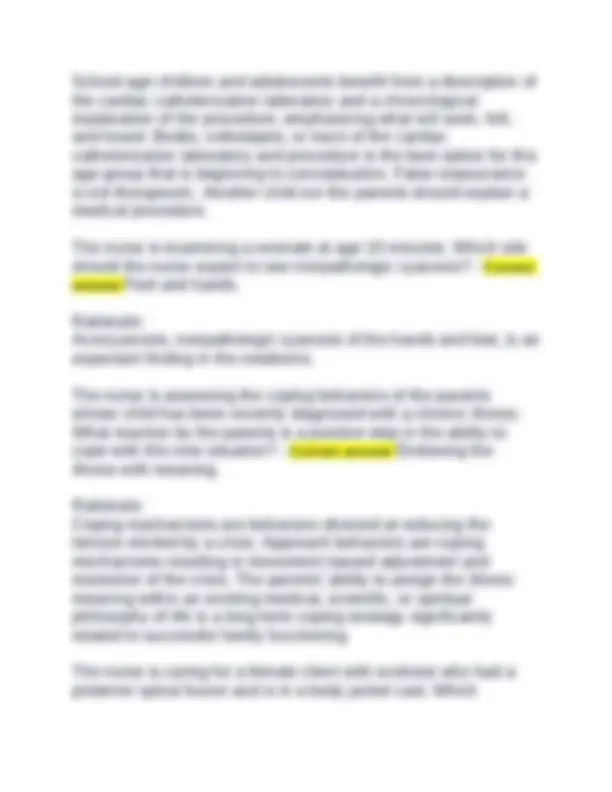
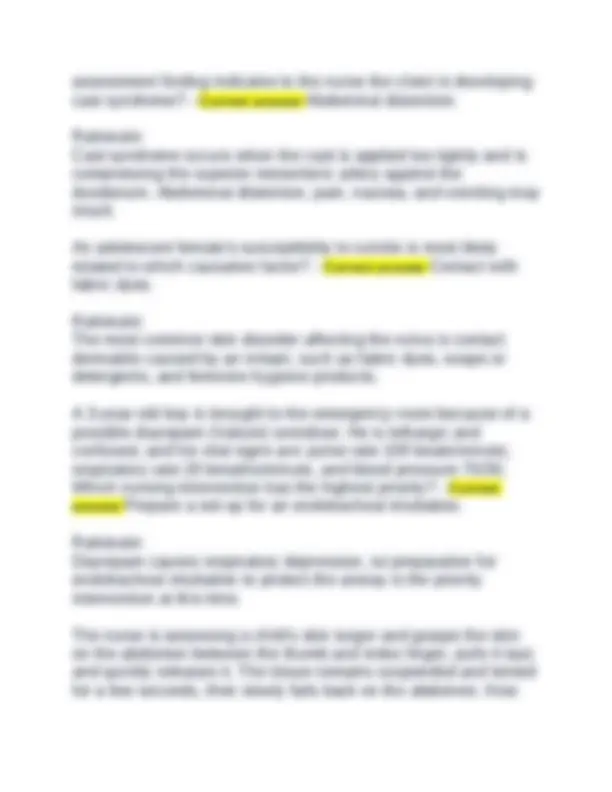
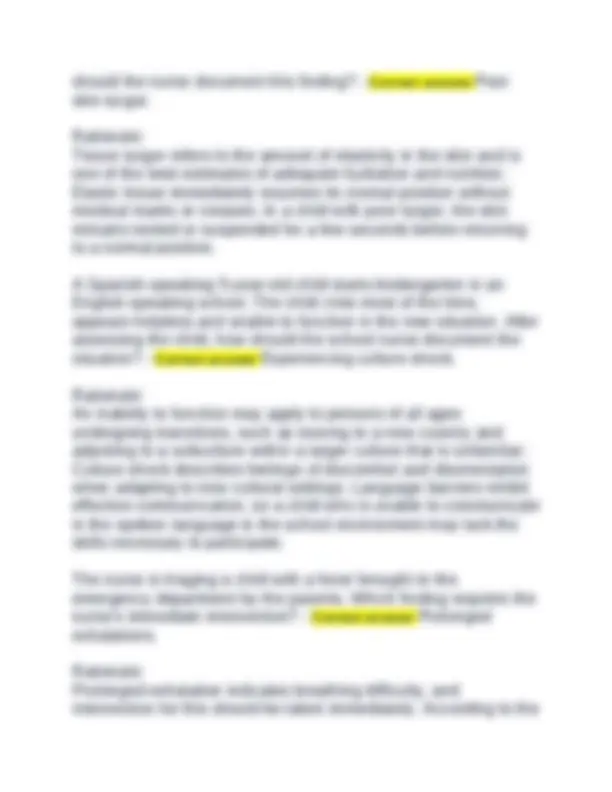
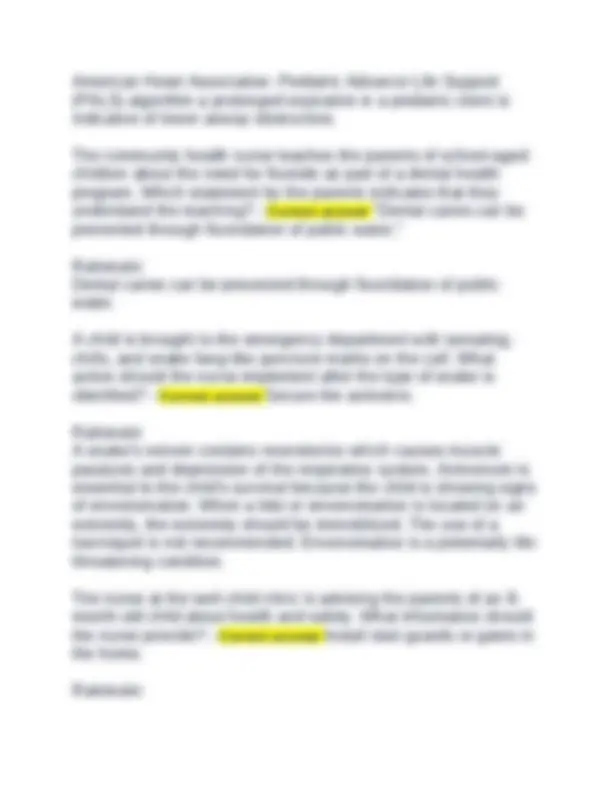
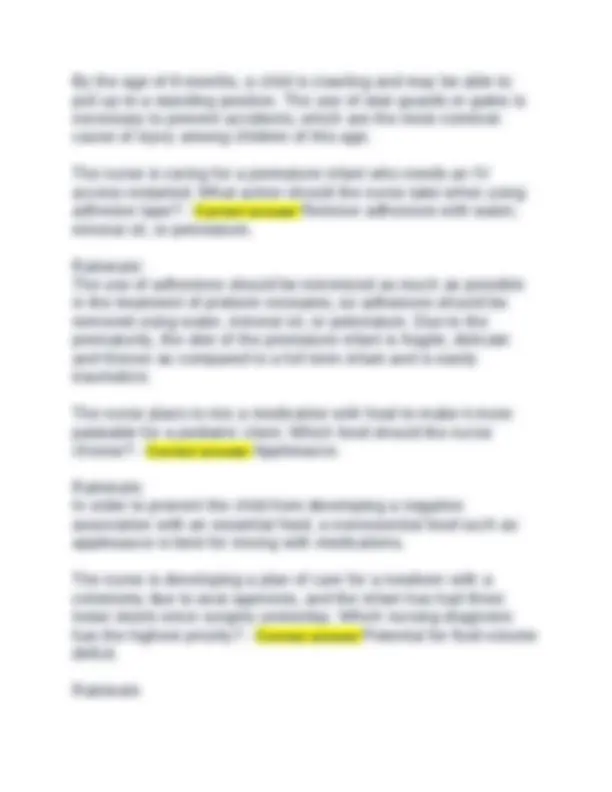



Study with the several resources on Docsity

Earn points by helping other students or get them with a premium plan


Prepare for your exams
Study with the several resources on Docsity

Earn points to download
Earn points by helping other students or get them with a premium plan
Community
Ask the community for help and clear up your study doubts
Discover the best universities in your country according to Docsity users
Free resources
Download our free guides on studying techniques, anxiety management strategies, and thesis advice from Docsity tutors
PEDS HESI Practice Test Questions With Answers And Rationales. PEDS HESI Practice Test Questions With Answers And Rationales.
Typology: Exams
1 / 61

This page cannot be seen from the preview
Don't miss anything!






















































The nurse is assessing a 2-year-old. What behavior indicates that the child's language development is within normal limits? - Correct answer Half of child's speech is understandable. Rationale: Between approximately 15 and 24 months of age, a child's speech is only half understandable. A child can begin counting and name colors usually between 3 and 5 years of age. And a child is capable of two - four word sentences between 18 months to 24 months of age. As part of the physical assessment of children, the nurse observes and palpates the fontanels. Which child's fontanel finding should be reported to the healthcare provider? - Correct answer A 6-month-old with failure to thrive that has a closed anterior fontanel. Rationale: At six months of age the anterior fontanel should be open, and it should not be closed until approximately 18 months of age. Premature closure of the fontanels is a condition called "craniosynostosis". The only treatment for this condition is surgery to reopen the fontanels, to allow and accommodate the infant's growing brain, otherwise if not surgical corrected, the infant will suffer severe neurological damage. The nurse must prevent a 2-year-old with severe eczema on the face, neck, and scalp from scratching the affected areas. Which nursing intervention is most effective in preventing further excoriation due to the pruritis? - Correct answer Place elbow restraints on the child's arms.
Rationale: Elbow restraints prevent arm flexion and the ability to reach to scratch the involved areas, but do not inhibit use of the hands for play activities. The nurse observes a 4-year-old boy in a daycare setting. Which behavior should the nurse consider normal for this child? - Correct answer Demonstrates aggressiveness by boasting when telling a story. Rationale: Four-year-old children are aggressive in their behavior and enjoy "tale telling" The clinic nurse is taking the history for a new 6-month-old client. The mother reports that she took a great deal of aspirin while pregnant. Which assessment should the nurse obtain? - Correct answer Type of reaction to loud noises. Rationale: Ototoxicity diminishes hearing acuity and causes symptoms of tinnitus and vertigo in older children who can express subjective symptoms, so assessing an infant's reaction to loud noises helps to determine an infant's risk for a hearing deficit related to a history of the mother taking an ototoxic drug, such as aspirin, while pregnant. When evaluating the effectiveness of interventions to improve the nutritional status of an infant with gastro-esophageal reflux, which intervention is most important for the nurse to implement? - Correct answer Record weight daily. Rationale:
answer Do not give if the child has chickenpox, the flu, or any other viral illness. Rationale: Pepto Bismol, Bismylate contains subsalicylate and if used in the presence of a viral illness, there is the potential of developing Reye's syndrome, a sometimes fatal condition for children. At 8 a.m. the unlicensed assistive personnel (UAP) informs the charge nurse that a female adolescent client with acute glomerulonephritis has a blood pressure of 210/110. The 4 a.m. blood pressure reading was 170/88. The client reports to the UAP that she is upset because her boyfriend did not visit last night. What action should the nurse take first? - Correct answer Administer PRN prescription of nifedipine (Procardia) sublingually. Rationale: After the nurse has verified the client's elevated blood pressure, the sublingual Procardia should be administered first because it lowers the blood pressure very quickly, before implementing any of the other interventions. What preoperative nursing intervention should be included in the plan of care for an infant with pyloric stenosis? - Correct answer Observe for projectile vomiting. Rationale: In pyloric stenosis, the valve between stomach and small intestine enlarges blocking the passage of food. The nurse needs to ensure suctioning equipment is closed by to help prevent aspiration from the projectile vomiting episodes and monitor for the state of metabolic alkalosis, which is a classic sign of pyloric stenosis.
The nurse is teaching a 12-year-old male adolescent and his family about taking injections of growth hormone for idiopathic hypopituitarism. Which adverse symptoms, commonly associated with growth hormone therapy, should the nurse plan to describe to the child and his family? - Correct answer Polyuria and polydipsia. Rationale: Signs and symptoms of diabetes or hyperglycemia need to be reported. Clients who are receiving growth hormones should be monitored to detect elevated blood sugars and glucose intolerance. Which finding in a 19-year-old female client should trigger further assessment by the nurse? - Correct answer Menstruation has not occurred. Rationale: Menstruation is an expected secondary sex characteristic that occurs with pubescence and typically occurs between the ages of 10 to 17, so the fact the client is 18 years old and has not experience menarche, should prompt further investigation to determine the cause of this primary amenorrhea. During administration of a blood transfusion, a child complains of chills, headache, and nausea. Which action should the nurse implement? - Correct answer Stop the infusion immediately and notify the healthcare provider. Rationale: The child is exhibiting signs of a reaction to the blood transfusion. The blood transfusion should be stopped immediately and the healthcare provider notified.
The nurse is having difficulty communicating with a hospitalized 6- year-old child. Which approach by the nurse is most helpful in establishing communication? - Correct answer Engage the child through drawing pictures. Rationale: Drawing pictures is a valuable form of non-verbal communication. It is easier for a child to express their emotions and feelings through the process of drawing than to express it verbally. As the nurse and child look at the drawings, a verbal story can be told that projects the child's thinking. The nurse is planning care for school-aged children at a community care center. Which activity is best for the children? - Correct answer Playing follow-the-leader. Rationale: School-aged children strive for independence and productivity (Erikson's Industry vs. Inferiority) and enjoy individual and group activities related to real-life situations, such as playing follow-the- leader. When planning the care for a child who has had a cleft lip repair, the nurse knows that crying should be minimized because it - Correct answer stresses the suture line. Rationale: Prevention of stress on the lip suture line is essential for optimum healing and the cosmetic appearance of a cleft lip repair. A full-term infant is admitted to the newborn nursery. After careful assessment, the nurse suspects that the infant may have an esophageal atresia. Which symptoms is this newborn likely to
have exhibited? - Correct answer Choking, coughing, and cyanosis. Rationale: "Choking, coughing, and cyanosis" includes the "3 Cs" of esophageal atresia caused by the overflow of secretions into the trachea. Esophageal atresia is a congenital birth defect in which there is no connection between upper esophagus and the lower esophagus and stomach. The upper esophagus ends in a blind pouch. A 2-year-old child with Down syndrome is brought to the clinic for his regular physical examination. The nurse knows which problem is frequently associated with Down syndrome? - Correct answer Congenital heart disease. Rationale: Congenital heart disease is the most common associated defect in children with Down syndrome. Clients with trisomy 21 are diagnosed with Down Syndrome. Clients affected by trisomy 13 are affected by a syndrome called "Patau's Syndrome" and clients with trisomy 18 are affected by a syndrome called "Edward's Syndrome". All three of these trisomy syndromes have some form of congenital cardiac anomalies present with these chromosomal defects. The nurse assigning care for a 5-year-old child with otitis media is concerned about the child's increasing temperature over the past 24 hours. Which statement is accurate and should be considered when planning care for the remainder of the shift? - Correct answer Tympanic and oral temperatures are equally accurate. Rationale: A tympanic membrane sensor approximates core temperatures because the hypothalamus and eardrum are perfused by the
affected bowel segment causes constipation and small diameter, brown-colored stools. Foul-smelling and fatty stool is associated with cystic fibrosis. Bile-colored and watery stool is common in gastroenteritis. Semi- solid and yellow stool is normal in breastfed neonates. In developing a teaching plan for a 5-year-old child with diabetes, which component of diabetic management should the nurse plan for the child to manage first? - Correct answer Process of glucose testing. Rationale: Developmentally, a 5-year-old has the cognitive and psychomotor skills to use a glucometer and to read the number (it is especially helpful if the nurse presents this activity as a game). The nurse is assigning care for a 4-year-old child with otitis media and is concerned about the child's increasing temperature over the past 24 hours. When planning care for this child, it is important for the nurse to consider that - Correct answer a tympanic measurement of temperature will provide the most accurate reading. Rationale: A tympanic membrane sensor is an excellent site because both the eardrum and hypothalamus (temperature-regulating center) are perfused by the same circulation. The sensor is unaffected by cerumen and the presence of suppurative or unsuppurative otitis media does not effect measurement. RULE OF THUMB: for management--sterile procedures should be assigned to licensed personnel. Management skills will be tested on the NCLEX! Rectal temperature measurement is less accurate because of the possibility of stool in the rectum.
A 6-month-old boy and his mother are at the healthcare provider's office for a well-baby check-up and routine immunizations. The healthcare provider recommends to the mother that the child receive an influenza vaccine. What medications should the nurse plan to administer today? - Correct answer All the immunizations with the influenza vaccine given at a separate site from any other injection. Rationale: At 6-months of age, the routine immunizations include Hepatitis B, DTaP, Hib (Haemophilus influenza type b) , PCV (Pneumococcal), IPV (inactivated poliovirus) and influenza. To ensure the infant receives the influenza vaccine, it should be given that same visit, at a separate site from any other injection site. A 15-year-old girl tells the school nurse that all of her friends have started their periods and she feels abnormal because she has not. Which response is best for the nurse provide? - Correct answer Explain that menarche varies and occurs between the ages of 12 and 18 years. Rationale: The nurse should provide a factual and reassuring explanation that focuses on individual variations of menarche, which can normally occur between 10 and 17 years of age. The nurse is giving preoperative instructions to a 14-year-old female client who is scheduled for surgery to correct a spinal curvature. Which statement by the client best demonstrates that learning has taken place? - Correct answer "I understand that I will be in a body cast and I will show you how you taught me to turn." Rationale:
Two-year-old children are egocentric and unable to share with other children. Toddlers demonstrate "parallel" play where they will play alongside with others, but not with others. The nurse is developing a plan of care for a 3-year-old who is scheduled for a cardiac catheterization. To assist in decreasing anxiety for the child on the day of the procedure, which intervention is best for the nurse to implement? - Correct answer Give the child a ride on a gurney to visit the cardiac catheterization lab and meet a nurse who works there. Rationale: Familiarizing the child and mother with the department by visiting the cath lab and meeting the personnel there prior to the procedure day should help decrease anxiety of the child and mother (who may have more anxiety than the child). During discharge teaching of a child with juvenile rheumatoid arthritis, the nurse should stress to the parents the importance of obtaining which diagnostic testing? - Correct answer Eye exams. Rationale: Visual changes leading to blindness can occur in children with juvenile idiopathic arthritis (JIA). The most common eye problem for clients with JIA is uveitis which can lead to glaucoma, cataracts, and permanent visual damage. These complications can be prevented if detected early, so it is important the parents are educated about the importance of eye exams for their child diagnosed wit JIA. The nurse is preparing a health teaching program for parents of toddlers and preschoolers and plans to include information about prevention of accidental poisonings. It is most important for the nurse to include which instruction? - Correct answer Store all toxic agents and medicines in locked cabinets.
Rationale: The only reliable way to prevent poisonings in young children is to make them inaccessible by storing them out of reach of children in locked cabinets. A 4-year-old girl continues to interrupt her mother during a routine clinic visit. The mother appears irritated with the child and asks the nurse, "Is this normal behavior for a child this age?" The nurse's response should be based on which information? - Correct answer Children need to retain a sense of initiative without impinging on the rights and privileges of others. Rationale: Children aged 3 to 6 are in Erickson's "Initiative vs. Guilt" stage, which is characterized by vigorous, intrusive behavior, enterprise, and strong imagination. At this age, children develop a conscience and must learn to retain a sense of initiative without impinging on the rights of others. The nurse is caring for a 12-year-old with Syndrome of Inappropriate Antidiuretic Hormone (SIADH). This child should be carefully assessed for which complication? - Correct answer Changes in level of consciousness. Rationale: The child must be monitored for signs and symptoms of hyponatremia, which creates secondary central nervous system alterations such as changes in level of consciousness, seizure, and coma. A 2-year-old child with gastro-esophageal reflux has developed a fear of eating. What instruction should the nurse include in the parents' teaching plan? - Correct answer Consistently follow a set mealtime routine.
Rationale: VSDs are a common congenital heart defect which means there is a hole in the septum wall separating the left and right ventricles. Dependent upon the size of the hole, will impact how much of oxygenated blood is shunted over to the right ventricle of the heart, decreasing amount of oxygenated blood pumped out to the rest of the body. The closure of VSDs will stop the oxygenated blood from being shunted from the left ventricle to the right ventricle. Surgery is being delayed for an infant with undescended testes. In collaboration with the healthcare provider and the family, which prescription should the nurse anticipate? - Correct answer A trial of human chorionic gonadotrophic hormone. Rationale: A trial of HCG (human chorionic gonadotrophic hormone) may aid in testicular descent, but does not replace surgical repair for true undescended testes. Undescended testes (cryptorchidism) may be found in the inguinal canal due to exaggerated cremasteric reflex. During routine screening at a school clinic, an otoscope examination of a child's ear reveals a tympanic membrane that is pearly gray, slightly bulging, and not movable. What action should the nurse take next? - Correct answer Ask the child if he/she has had a cold, runny nose, or any ear pain lately. Rationale: More information is needed to interpret these findings. The tympanic membrane is normally pearly gray, not bulging, and moves when the client blows against resistance or a small puff of air is blown into the ear canal. Since this child's findings are not completely normal, further assessment of history and related
signs and symptoms is indicated for accurate interpretation of the findings. The nurse receives a lab report stating a child with asthma has a theophylline level of 15 mcg/dl. What action will the nurse take? - Correct answer Pass the information on in the report. Rationale: The therapeutic level of theophylline is 10 to 20 mcg/dl, so the child's level is within the therapeutic range. This information evaluates the prescribed therapy and should be communicated in the nurse's report. The nurse reviews the latest laboratory results for a child who received chemotherapy last week and identifies a reduced neutrophil count. Which nursing diagnosis has the highest priority for this child? - Correct answer Risk for infection. Rationale: Chemotherapy (CT) suppresses phagocytotic neutrophils and places the child at risk for infection, which is the priority nursing diagnosis at this time. A 17-year-old male student reports to the school clinic one morning for a scheduled health exam. He tells the nurse that he just finished football practice and is on his way to class. The nurse assesses his vital signs: temperature 100 F, pulse 80, respirations 20, and blood pressure 122/82. What is the best action for the nurse to take? - Correct answer Tell the student to proceed directly to his regularly scheduled class. Rationale: This student has just completed football practice, and increased muscle activity increases body heat production. A temperature of
Rationale: Steatorrhea is defined as stools with an abnormally high fat content that are usually foul smelling and float on water. Cystic fibrosis is an autosomal recessive gene condition that affects the secretory glands and can affect many parts of the body. The digestion system is affected by blockage of the glands involved in digestion such as the pancreas and gall bladder which results in the presence of steatorrhea stools reflective of the fats not digested and absorbed in the child's intestines. A 6-month-old infant with congestive heart failure (CHF) is receiving digoxin elixir. Which observation by the nurse warrants immediate intervention? - Correct answer Apical heart rate of 60. Rationale: A heart rate of 60 beats per minute is much lower than normal for a 6-month-old and warrants immediate intervention. The normal heart rate for a 6-month-old is 80 to 150 beats per minute when awake, and a rate of 70 while sleeping is considered within normal limits. A 12-month-old boy is admitted with a respiratory infection and possible pneumonia. He is placed in a mist tent with oxygen. Which nursing intervention has the greatest priority for this infant?
Preoperative nursing care for a child with Wilms' tumor should include which intervention? - Correct answer Put a sign on the bed reading, "DO NOT PALPATE ABDOMEN." Rationale: Prevention of abdominal palpation minimizes the risk of rupturing the encapsulated tumor and subsequent metastasis. A 3-year-old client with sickle cell anemia is admitted to the Emergency Department with abdominal pain. The nurse palpates an enlarged liver, an x-ray reveals an enlarged spleen, and a CBC reveals anemia. These findings indicate which type of crisis?